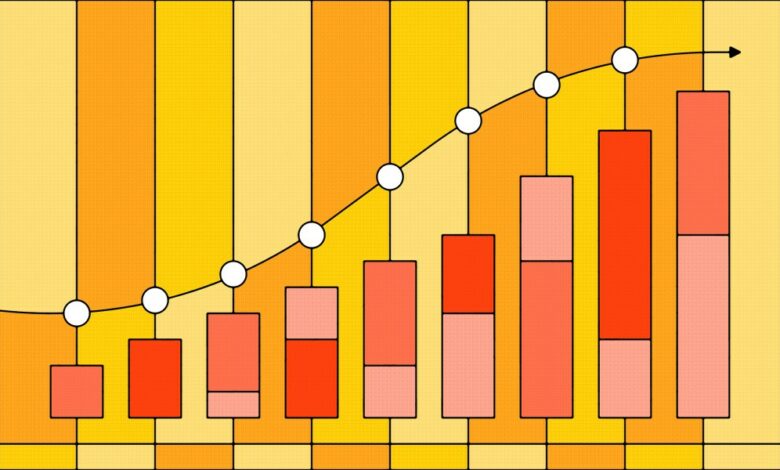Best high-yield savings account rates: Updated daily

Your savings can score a superior interest rate—you just have to know where to look. Right now, the best high-yield savings accounts offer annual percentage yields (APYs) of 5% or more.
The Fortune Recommends editorial team looked at more than 60 banks and credit unions and identified several financial institutions offering high yields, some more than 11 times the national average.
Top 20 highest savings rates on the market today
SPONSORED PARTNER
SoFi Checking & Savings
| APY | 4.60% |
| Minimum Balance Required to Earn APY | $0 |
| Minimum Opening Deposit | $0 |
| Monthly Maintenance Fee | None |
Calculate interest earnings on top savings accounts
Are you curious about your earning potential with these banks? Use the calculator below to see how much interest you could earn with various deposits, contributions, and interest rates. Keep in mind that the APY on savings accounts can fluctuate without warning, so if you want to lock in a high interest rate for an extended time, you may want to consider certificates of deposit (CDs) instead.
The best high-yield savings accounts: Editors’ picks
Our picks for this month’s best high-interest savings accounts offer high yields, low fees, and other important features such as ATM access, online and mobile banking, and more. Plus, each account is protected by the Federal Deposit Insurance Corporation (FDIC), which insures up to $250,000 per depositor per account, giving you an extra sense of security for your savings.
Note: APYs in our list below are updated daily, but are subject to change.
*Last updated April 26, 2024. Read our full methodology here.
SPONSORED PARTNER
SoFi Checking & Savings
| APY | 4.60% |
| Minimum Balance Required to Earn APY | $0 |
| Minimum Opening Deposit | $0 |
| Monthly Maintenance Fee | None |
The best high-yield savings accounts: Editors’ picks
Our picks for this month’s best high-interest savings accounts offer high yields, low fees, and other important features such as ATM access, online and mobile banking, and more. Plus, each account is protected by the Federal Deposit Insurance Corporation (FDIC), which insures up to $250,000 per depositor per account, giving you an extra sense of security for your savings.
Note: APYs in our list below are updated daily, but are subject to change.
UFB Secure Savings
| APY | 5.45% |
| Minimum Balance Required to Earn APY | $0 |
| Minimum Opening Deposit | $0 |
| Monthly Maintenance Fee | $0 |
Why we picked it
UFB Direct’s savings account rivals competitors in rate and (lack of) fees. However, this account stands out for its massive ATM network, highly rated mobile app, and generous customer service hours, which include 24/7 phone support.
You’ll likely want this account in addition to those at your primary bank since UFB doesn’t offer a checking account. However, your UFB preferred savings account also includes a complimentary ATM card for fast cash.
Varo High-Yield Savings
| APY | 5.00% |
| Minimum Balance Required to Earn APY | $0 |
| Minimum Opening Deposit | $0 |
| Monthly Maintenance Fee | $0 |
Why we picked it
With a Varo Bank account, you can earn a whopping 5.00% APY on your savings, but you’ll need to meet some qualifications first. When you first invest, you’ll earn 3% on your balance. To earn the 5.00% APY, you’ll need to meet one of these two requirements:
- Receive qualifying direct deposits of $1,000 or more in your account
- Have a positive balance on both your Varo bank and savings account
However, note that you’ll only receive a 5.00% APY on balances up to $5,000. Any additional balance above that amount earns 3%. While Varo doesn’t offer the best APY, it does provide helpful savings tools, such as a round-up feature that rounds up your spending on a transaction and stashes that money in your savings account.
Why we picked it
TAB’s high-yield savings account is a straightforward, no-frills bank account with no monthly fees or minimum opening deposits. You’ll earn a stellar 5.27% APY with this FDIC-insured bank account.
TAB bank customers can also download the mobile app to keep track of their transactions, transfers, and deposits.
Why we picked it
With Newtek Bank, you get a low-cost savings account with a stellar rate. There’s no minimum opening deposit or monthly maintenance fees. Plus, you only need to have a balance of $0.01 to earn interest.
Newtek also offers many customer service options, so if you need help, you can connect with them via video, audio, text chat, or phone call.
Why we picked it
Like other banks on our lisit, Cloudbank 24/7 offers their high-yield savings account through Raisin. With a 5.26% APY and a minimum opening deposit of $1, opening a Cloud 24/7 savings account is as simple as opening an online Raisin account and depositing money to start earning interest.
If you ever need help with your account, you can reach Raisin customer service via email, phone, or secure messaging on their site.
See more savings accounts we’ve reviewed
| Account type | APY* | Minimum opening deposit | Welcome bonus | Learn more |
|---|---|---|---|---|
| Sponsored partner SoFi Checking & Savings |
4.60% | $0 | Up to $300 | View offer |
| UFB Direct Secure Savings | 5.45% | $0 | None | View offer |
| Credit Karma Money Save | 5.10% | $0 | None | View offer |
| Varo High-Yield Savings | 5.00% | $0 | None | View offer |
| TAB Bank High-Yield Savings | 5.27% | $0 | None | View offer |
| Newtek Bank Personal High-Yield Savings | 5.25% | $0 | None | View offer |
| Upgrade Premier Savings | 5.21% | $0 | None | View offer |
| Cloudbank 24/7 High-Yield Savings Account | 5.26% | $1 | None | View offer |
| Laurel Road High-Yield Savings | 5.00% | $0 | None | View offer |
| LendingClub High-Yield Savings | 5.00% | $100 | None | View offer |
| Evergreen Bank Group | 5.25% | $0 | None | View offer |
| Best high-yield savings accounts: Editors’ picks | ||||
|---|---|---|---|---|
| Sponsored partner SoFi Checking & Savings |
View offer | |||
| 4.60% | ||||
| $0 | ||||
| Up to $300 | ||||
| UFB Direct Secure Savings | View offer | |||
| 5.45% | ||||
| $0 | ||||
| None | ||||
| Credit Karma Money Save | View offer | |||
| 5.10% | ||||
| $0 | ||||
| None | ||||
| Varo High-Yield Savings | View offer | |||
| 5.00% | ||||
| $0 | ||||
| None | ||||
| TAB Bank High-Yield Savings | View offer | |||
| 5.27% | ||||
| $0 | ||||
| None | ||||
| Newtek Bank Personal High-Yield Savings | View offer | |||
| 5.25% | ||||
| $0 | ||||
| None | ||||
| Upgrade Premier Savings | View offer | |||
| 5.21% | ||||
| $0 | ||||
| None | ||||
| Cloudbank 24/7 High-Yield Savings Account | View offer | |||
| 5.26% | ||||
| $1 | ||||
| None | ||||
| Laurel Road High-Yield Savings | View offer | |||
| 5.00% | ||||
| $0 | ||||
| None | ||||
| LendingClub High-Yield Savings | View offer | |||
| 5.00% | ||||
| $100 | ||||
| None | ||||
| Evergreen Bank Group | View offer | |||
| 5.25% | ||||
| $0 | ||||
| None | ||||
What is a high-yield savings account (HYSA)?
A high-yield savings account works just like a traditional savings account. It’s a deposit account at a credit union or bank that you can use for saving and earning interest on your money. The main difference is that the high-yield savings account offers a much higher annual percentage yield (APY) on the money you keep in your account.
APY
The most recent rates from the FDIC put the national savings APY average at 0.46%, while there are many high-yield savings accounts that offer a 4.00% APY or higher.
Monthly maintenance fee
Some financial institutions charge a monthly fee to cover the administrative costs of providing a savings account. These fees can often be waived by meeting certain requirements, such as maintaining a minimum balance or linking a checking account. However, fees can easily wipe away your interest earnings, so choosing an account that charges minimal or no fees is important, if possible.
Minimum deposit
You may be required to deposit a minimum amount of money to open a high-yield savings account. Depending on the account, the amount can range from $0 to $1,000 or more. It’s also common for high-yield savings account rates to be tiered, meaning higher rates are available for higher balances. Always check the balance requirements of an account to find out if you need to meet a certain threshold to earn the advertised rate.
Alternatives to high-yield savings accounts
High-yield savings accounts differ from other types of deposit accounts in a few key ways.
- Access to your savings: High-yield savings accounts are more liquid than other types of accounts like CDs. Withdrawing money from a CD before maturity could result in an early withdrawal penalty. With a high-yield savings account, you may still be limited in how many withdrawals you can make within a particular time, but you still have some access to your money. Similar to traditional savings and money market accounts, you may also have debit cards and/or check privileges.
- High-yield savings accounts offer variable APYs: The APY on your high-yield savings account fluctuates, similar to a traditional savings account or money market account. For savers who prefer a fixed rate, a CD may be a better option, but it would mean giving up access to your funds for the duration of your CD term until your account reaches maturity.
High-yield savings accounts vs. traditional savings accounts
The primary difference between a high-yield savings account and a traditional savings account lies in their interest rates. High-yield savings accounts offer significantly higher interest rates compared to traditional savings accounts, which means that the money saved in a high-yield account grows faster. In some cases, high-yield accounts might come with more restrictions, such as limitations on the number of withdrawals and higher minimum balance requirements.
High-yield savings accounts vs. CDs
High-yield savings accounts are similar to traditional savings accounts, with the key difference being that high-yield accounts typically offer a more generous APY. They differ from CDs in that high-yield savings accounts preserve access to your funds, while CDs require that you commit to locking up your funds for a fixed term if you hope to avoid a penalty.
High-yield savings accounts vs. money market accounts
High-yield savings accounts are similar to money market accounts in that you’ll earn interest on your balance and can easily access your funds. One key difference between the two account types is that you may need to deposit and maintain a certain balance to open a money market account, and in some cases, the higher the balance, the higher your rate may be.
Our methodology
The Fortune Recommends™ team collaborated with industry leader Curinos to bring you savings accounts with the highest rates from around the country. The rates in this article only cover online and brick-and-mortar banks; they do not include credit unions.
For the editors’ picks, we compared more than 60 online savings accounts and specifically looked for accounts available to customers in the U.S. regardless of where they’re located, subject to the terms of each account. Our methodology ranked each account in these core categories:
- APY (50%): This number represents the real rate of return on your balance; the higher the APY, the better.
- Monthly fees (10%): Some banks charge monthly maintenance fees. We ranked banks with lower (or zero) monthly fees higher on the list.
- Minimum amount to earn APY (10%): To earn the high APY, some banks require that you maintain a certain dollar amount in the account, which we view as a limiting factor.
- Minimum opening deposit (10%): Some financial institutions require a deposit amount when you open your account. We rate a higher opening deposit as less attractive.
- Mobile app rating (10%): Many banks have a mobile app you can use to manage your account. We looked at banks’ mobile app ratings in the Apple store.
- Money management tools (5%): Some banks offered digital tools that make it easier for customers to track their spending and saving.
- Customer support (5%): Top picks offer customers various ways to get in contact: chat support, by phone, or even email—our team most highly rated phone support.
Frequently asked questions
Are high-yield savings accounts safe?
Yes, if the account is at a bank or credit union insured by the Federal Deposit Insurance Corporation (FDIC) or the National Credit Union Association (NCUA), respectively. The FDIC insures banks up to $250,000 per depositor, per bank, for each account ownership category. Credit unions are insured by the NCUA, which offers coverage up to $250,000 per share owner, per insured credit union, for each account ownership category.
Are high-yield savings accounts taxable?
If you choose to use a high-yield savings account, you should be aware of the tax implications that come with it. The IRS considers interest earned on the money in your account taxable interest. Your financial institution will typically send you a 1099-INT statement for any interest earned over $10, and the amount you owe will depend on how much interest you’ve earned and your tax bracket.
How are savings rates set?
Individual banks set savings rates loosely based on the federal funds rate—the interest rate that banks charge other banks when they lend one another money, usually overnight or for a few days. When the Fed hikes rates, this can raise the cost of borrowing and motivate banks to raise their APYs to attract new customers.
How often do high savings rates change?
Savings rates can change at any time. It’s important to remember that the rate information provided on the day you open the account is not a fixed rate. Banks and credit unions can, and likely will, adjust rates based on changes in the economy and interest rate increases or decreases by the Fed.
How often can I withdraw money from a high-yield savings account?
According to federal law, high-yield savings accounts allow you to make withdrawals or transfer funds out of your account up to six times per month without paying any fees. However, this rule was loosened in 2020 during the coronavirus outbreak, and customers can now make an unlimited number of transfers and withdrawals from their savings account.
In which situation would a high-yield savings account be the best banking choice?
A high-yield savings account is a viable option for savers who are looking to save money for a large purchase like a house, a short-term or mid-range financial goal, or who want to maximize their savings and keep their money safe in a federally-insured account.
What is a good high-yield savings account rate?
What’s considered a “good” rate is somewhat subjective. The national average savings account rate is 0.47%, so any rate above that would be considered above-average. However, some banks offer savings accounts that offer an APY that exceeds 4%. So, if you’re looking for a high-yield savings account, it pays to shop around to find the highest rates available.
What’s the difference between APY vs. interest rate?
The interest rate is the percentage of your account balance that the bank pays you in interest over the course of a year, not factoring in the effects of compounding. APY, on the other hand, considers the interest compounding frequency. Therefore, APY gives you a more accurate picture of your actual earnings over a year.
Source link




